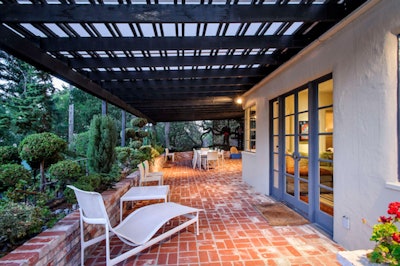
To be successful amid the outdoor living boom, it's critical for retailers and builders to stay abreast of rapidly changing consumer tastes in backyard products. To help keep your product lines up to date, AQUA has partnered with design megasite Houzz to bring you more content about outdoor living, from pools and spas to outdoor kitchens and patio furniture. Here, a Houzz expert shares just a few ways you can incorporate brick into the backyard.
Brick is a classic building material. For the landscape, it’s an easy-to-maintain and extremely durable paving material that can be set in many patterns. The advantage of brick over other modular pavers is that it doesn’t lose its color over time and doesn’t require as much cleaning or maintenance as concrete pavers.
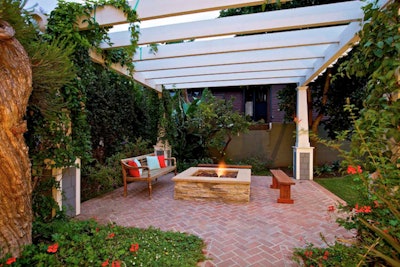
Photo by Christian Rice Architects Inc
The basics: Brick is considered a natural building material because it is made from clay and shale. Its durability and strength come from the firing process, where the clay is heated in a kiln and the materials bind together. Because of the kiln process, bricks are super durable and do not require a sealer. They can last as a paving material for many decades with minimal maintenance.
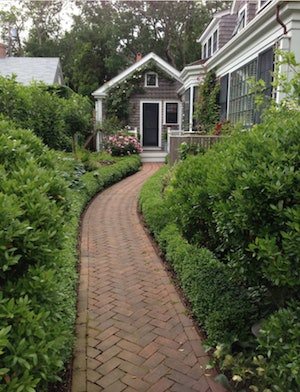
Photo on right by Gregory Lombardi Design
Pros
- Durable and strong
- Color-fast; won’t fade
- Low-maintenance
- Easy to mix and match with other materials
- Reusable
Cons
- Limited color range
- Corners can chip over time (unless you use bricks with beveled edges)
- Initial installation cost higher than for concrete
Shown: Herringbone-pattern brick walkway set with a soldier course edge. The soldier course adds stability to the brick paving.
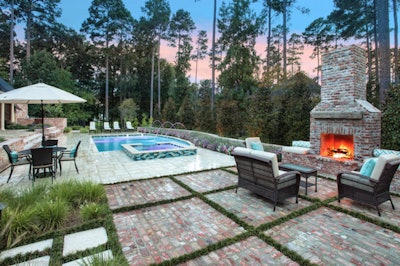
Photo by Morehead Pools
Size and color: Bricks fire to a reddish color that can vary based on exactly how the bricks are produced. Sizes are mostly within the 4-by-8-inch range, with thicknesses of 2½ to 4 inches. Driveways and applications with heavy loads require brick at least 3 inches thick.
RELATED: Connect With Skilled Driveway Paving Professionals
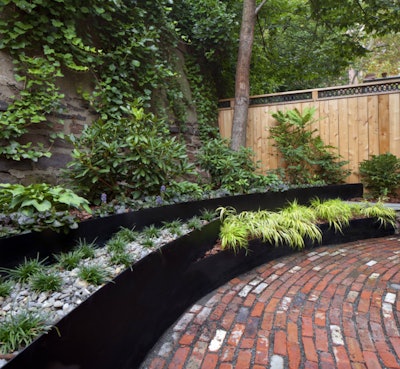
Photo by New Eco Landscapes
Special considerations: Adequate prep work is necessary when using brick as paving. The ground must be graded so that water drains from the surface, and the subgrade must have a drainage layer of compacted aggregate to properly support an even brick surface.
Maintenance: Remove stubborn stains with a little soapy water and a wire brush. There’s disagreement about whether clay bricks need to be sealed every few years. Bricks have been around for ages without the use of sealants, so I recommend skipping it. Check with your brick supplier before applying any product, because generic paver sealant is not good for clay bricks.
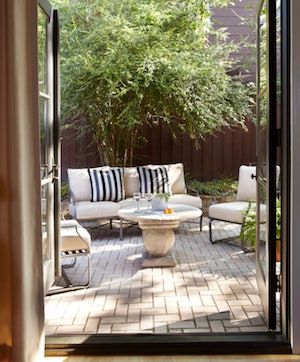
Shown: Bricks set in a circular pattern, commonly used with other brick patterns to add interest.
Photo on right by Denise McGaha Interiors
Setting bricks: After the subgrade and drainage layers are built, bricks can either be installed on a sand setting bed with sand-swept joints or mortared in place on a concrete foundation.
- In mortar: This method requires bricks to be mortared in place on a concrete slab, with mortared joints between them.
- On sand: This is a more maintenance-intensive option because the sand needs periodic additions. Mold and tiny weeds can also grow in the joints. Polymeric sand needs less maintenance than traditional sand because it binds together and does not need to be replaced.
Brick, like all durable modular paving, can be reset if the pavers become unevenly settled. The best way to ensure your brick stays level for many years is to create a great foundation and to set the paving with one of the above tried-and-true methods.
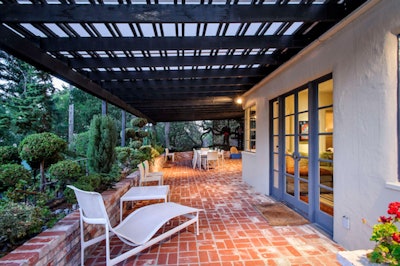 Dennis Mayer Photographer
Dennis Mayer Photographer
Photo by Dennis Mayer Photographer
RELATED: More Popular Paving Materials and Guides
Popular brick patterns. Bricks are wonderful modular units that make strong, stable paving when set together in tight patterns. Here are the three most common brick patterns:
- Running bond: The simplest pattern and the easiest to lay in place; typical running lines with offset joints are great for making clean pattern lines in rectangular spaces.
- Basketweave: This pattern has pairs of bricks set at 90 degrees to each other; it’s a great pattern for patios and a nice way to mix up the simple running bond.
- Herringbone, 45 degrees or 90 degrees: Great for driveways because of its stability under heavy loads.











































